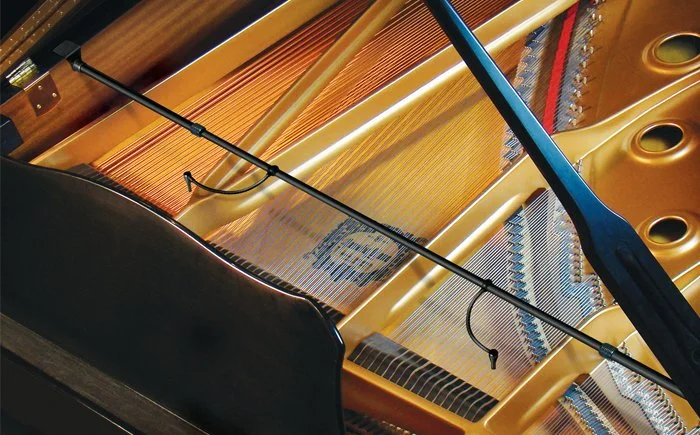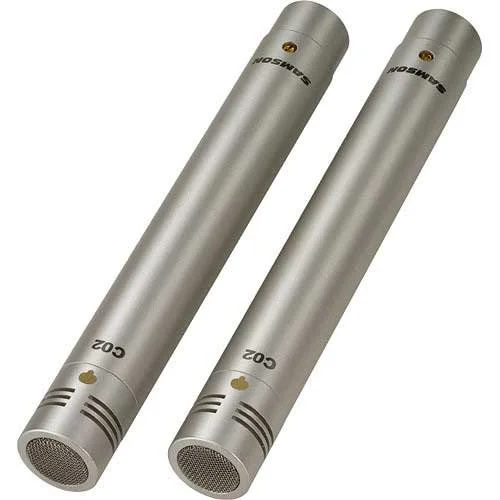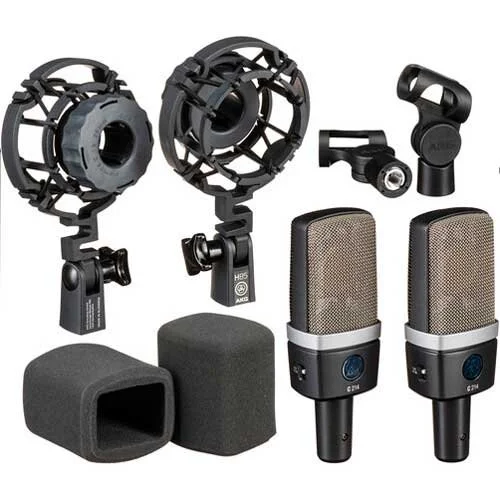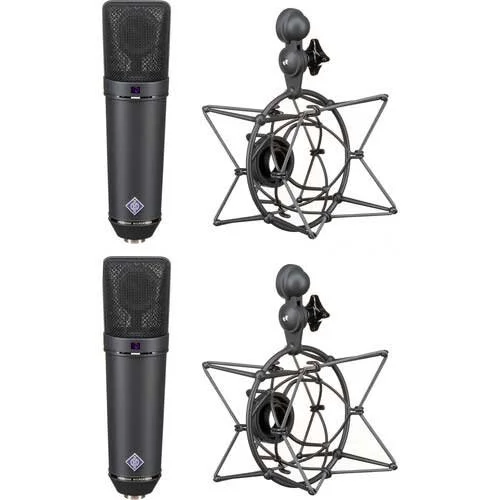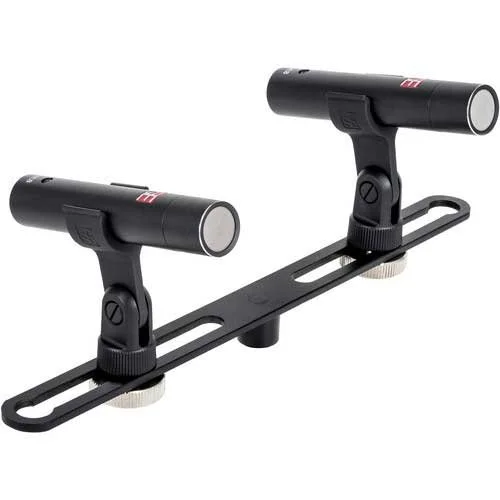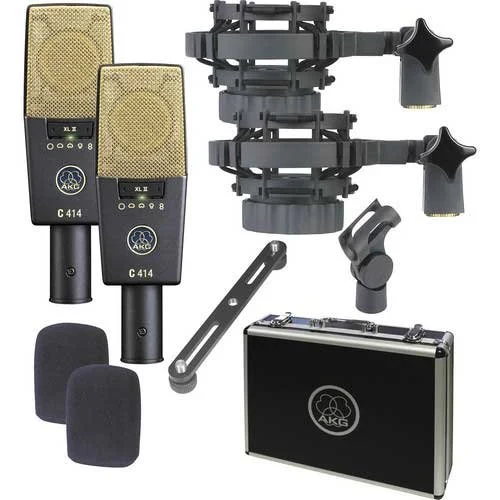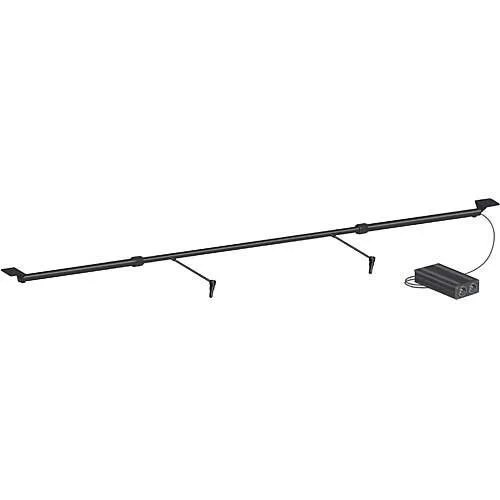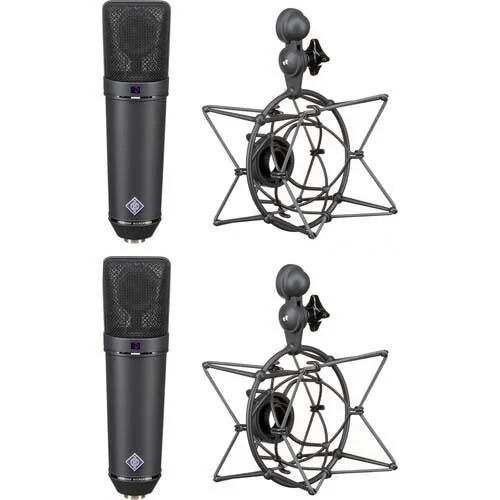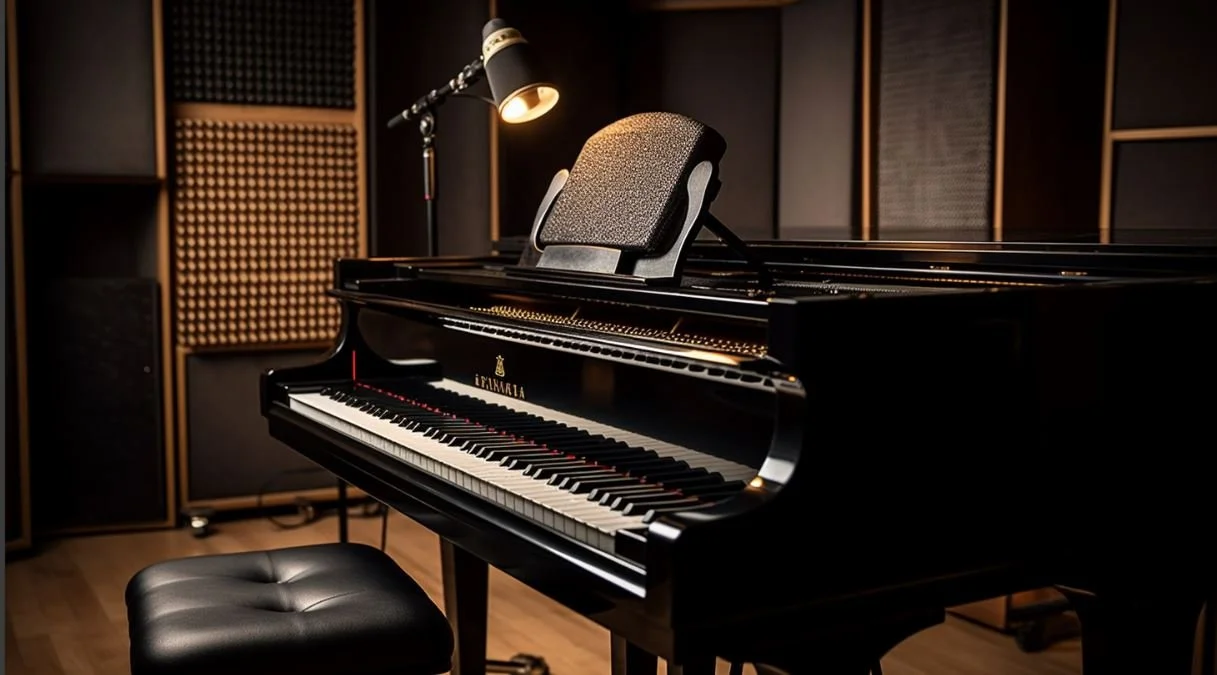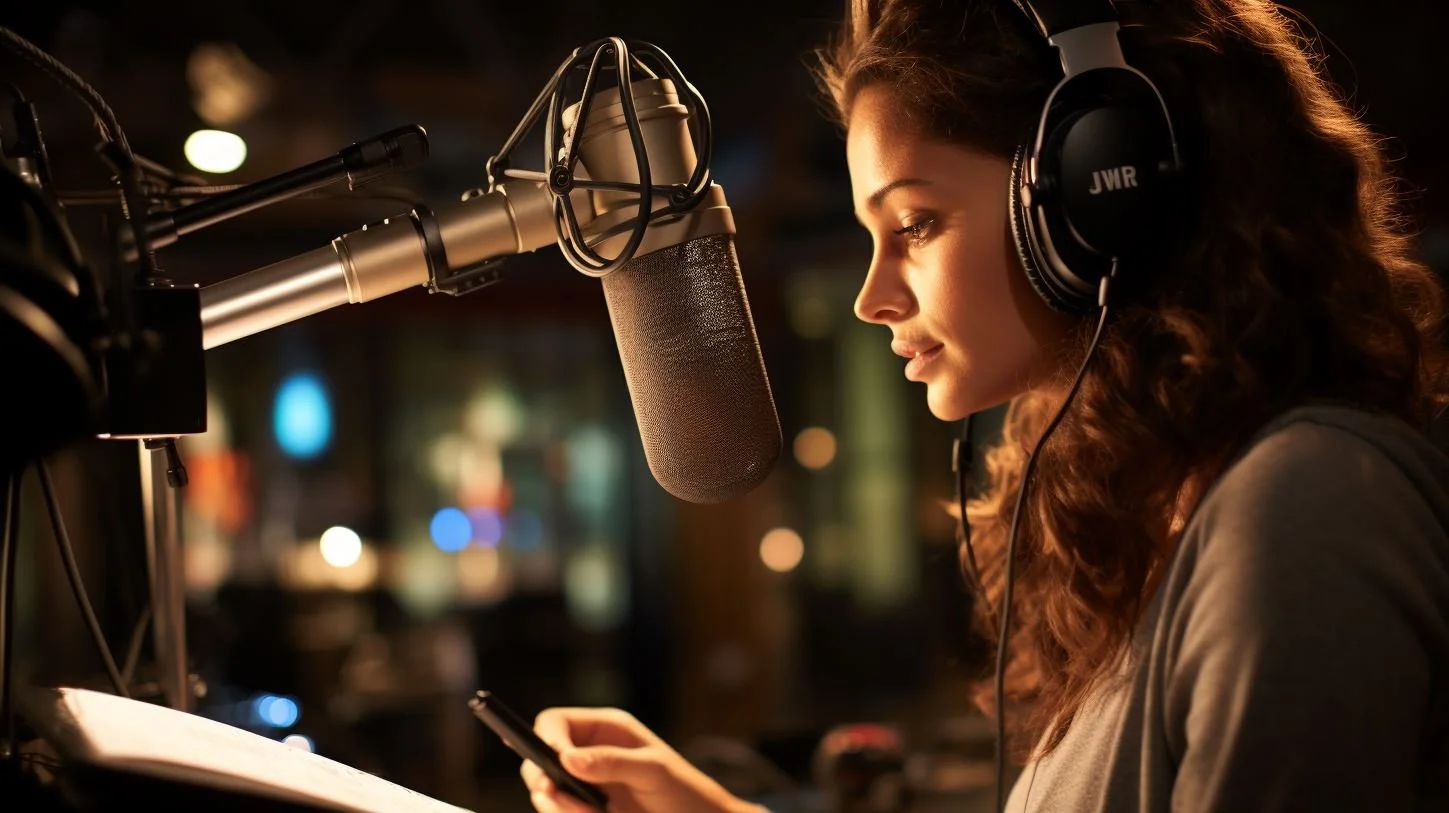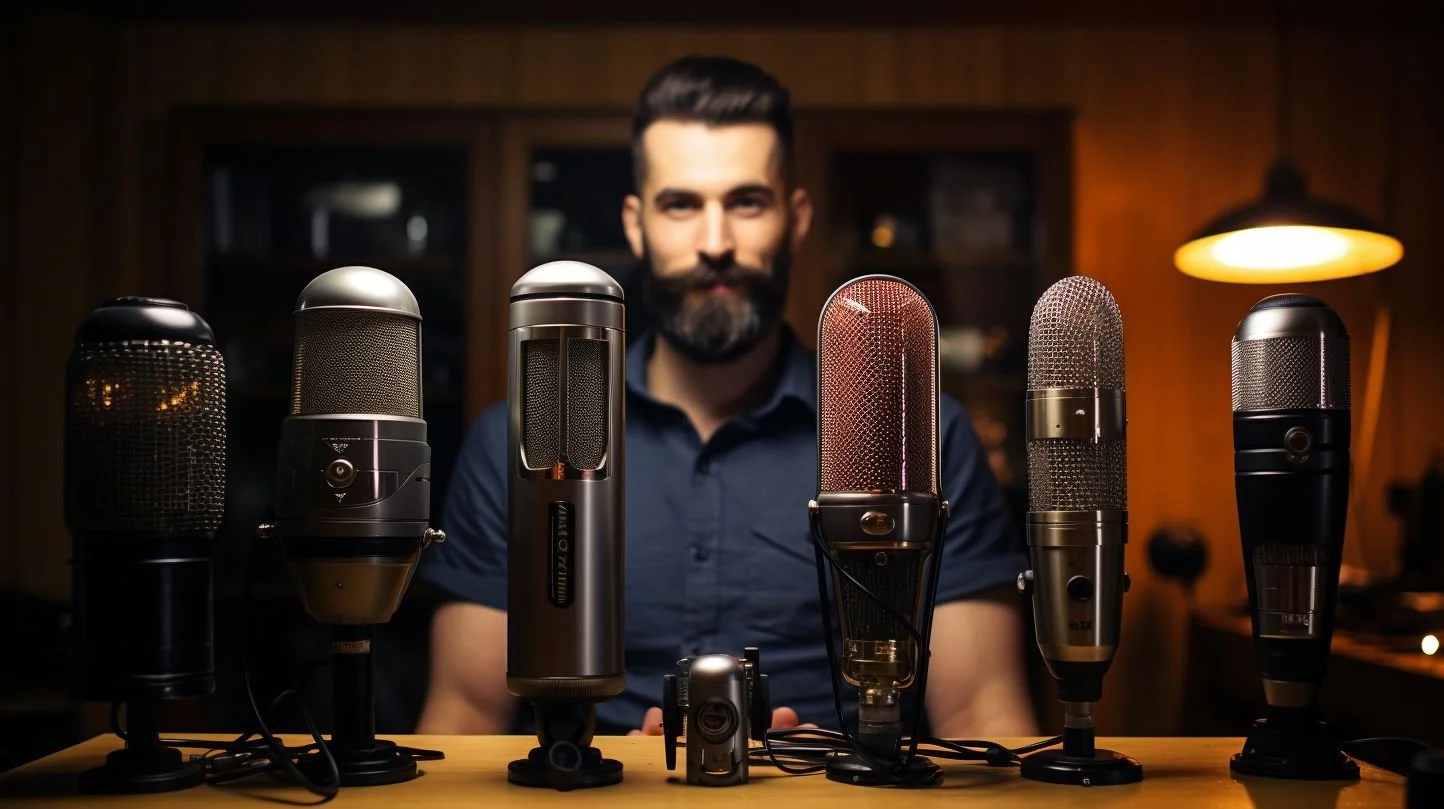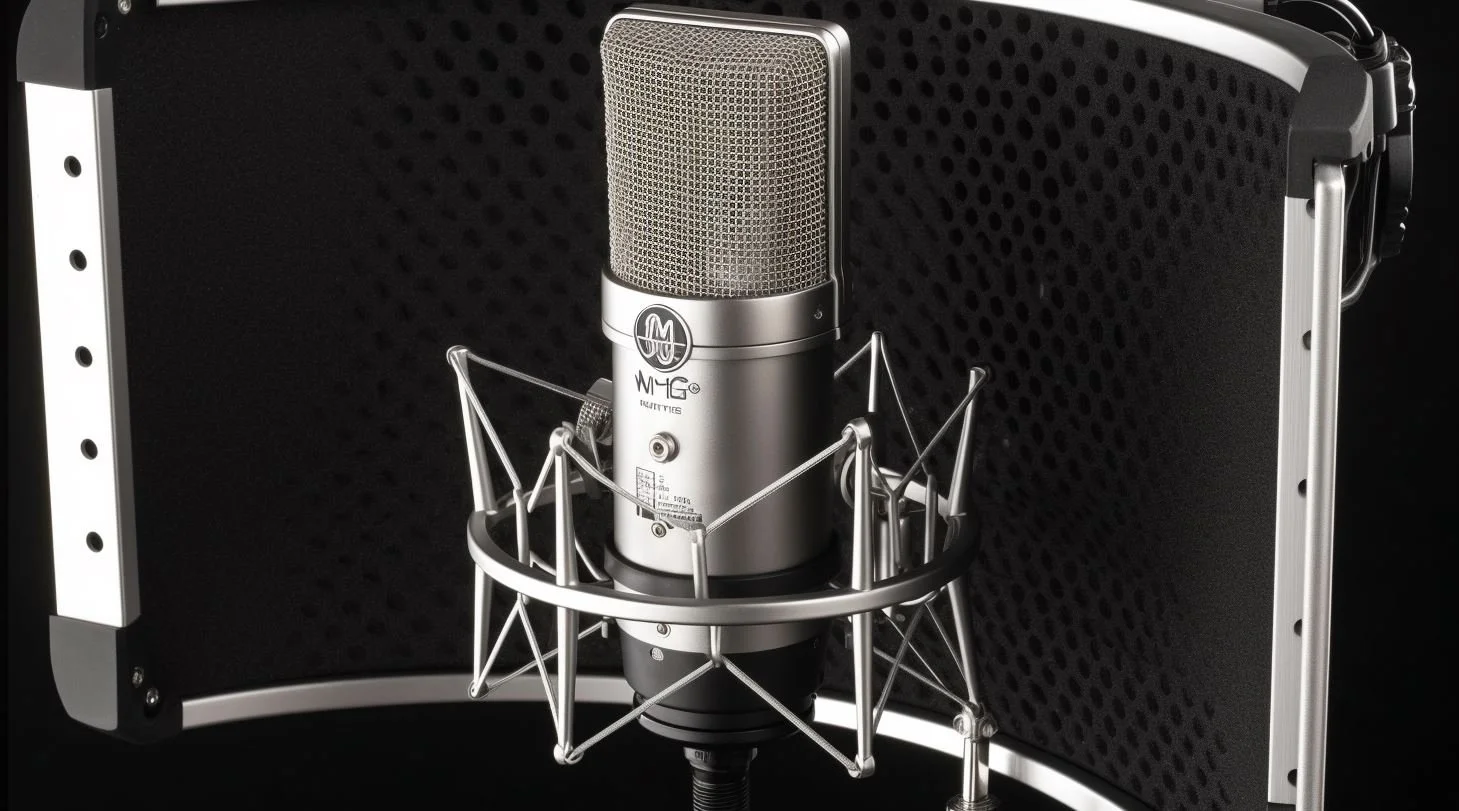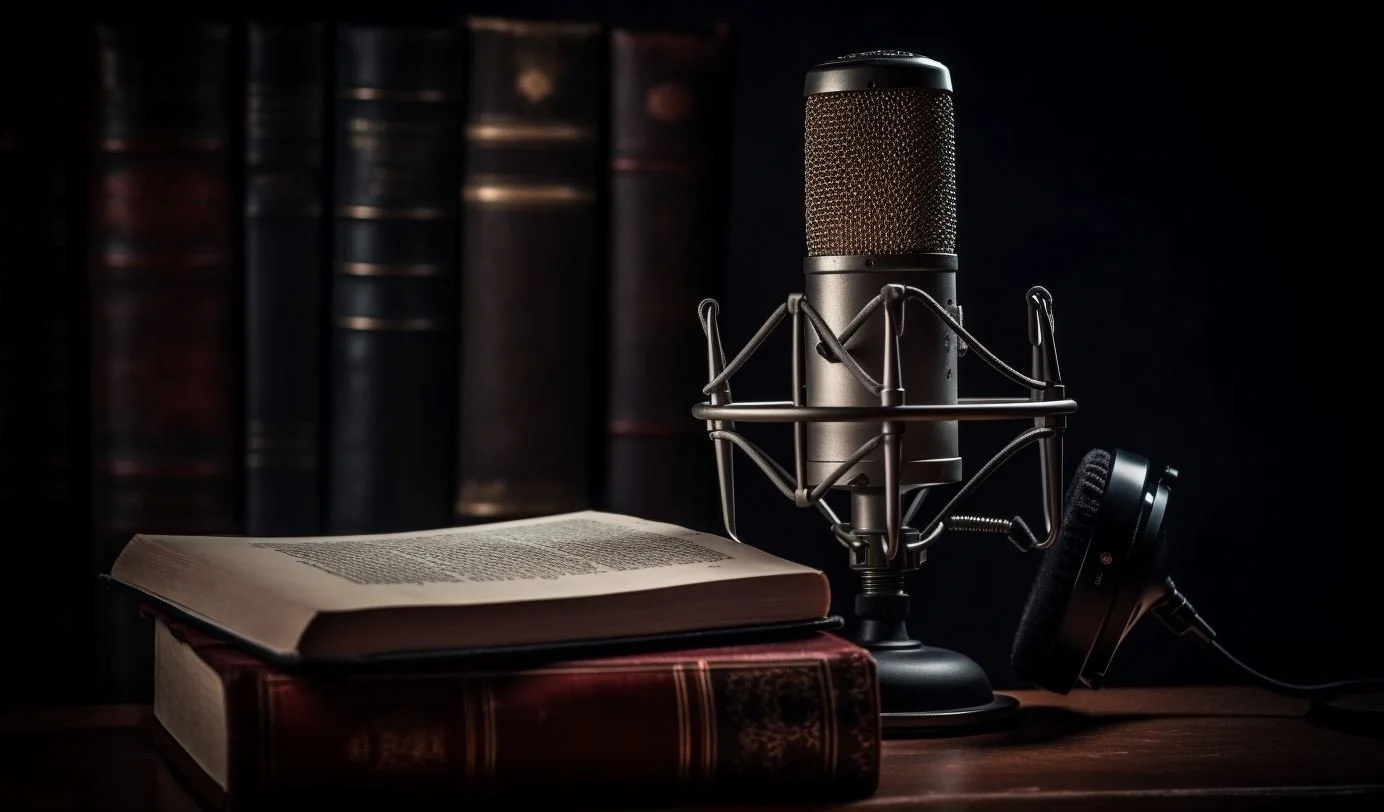Best Microphone for Recording Piano
Striking a Chord: Unveiling the Finest Microphones for Piano Mastery in Recording
Recording a piano requires a microphone that can capture its broad frequency range.
Condenser microphones are typically preferred over dynamic ones for their wider frequency response.
Optimal microphone placement is crucial and often involves positioning the mic close to the sound source, either inside the piano or near it, to capture the desired tonal quality.
This can include placing mics near the hammers for a sharper attack or over the strings for desired brightness or bass response.
Using multiple microphones can help achieve a balanced sound, especially for stereo recording, but the exact placement may need adjustment based on the individual piano and room acoustics.
The selection of microphones should be made with attention to their ability to accurately capture the complex sounds of the piano.
Cardioid vs. Omnidirectional Mics for Piano
Cardioid or omnidirectional microphones can both be used to capture stunning piano recordings.
The choice really comes down to your personal taste.
Although cardioid and omnidirectional mics sound very different in most scenarios, their differences are more subtle when recording piano due to their close proximity to the strings and hammers.
Pianos are most commonly recorded with microphones positioned 8 inches from the hammers and 8-11 inches above the strings.
At this close distance, cardioids and omnis sound similar:
Omnis will provide a more open sound with more reflections.
Cardioids will provide a tighter focus with more low-frequency presence.
In my opinion, the real consideration between omnis or cardioids comes down to the proximity effect.
The proximity effect is a sonic phenomenon with cardioid microphones that makes low-frequency sounds louder and richer when they’re positioned close to a sound source.
Podcasters and narrators often take advantage of this effect and use cardioid microphones to make their voices sound more full, resonant, and rich.
However, this is not always desirable when recording piano.
While using cardioids can enhance your piano recordings, it will take some experimentation and testing to find the perfect position for your mic over the low end of the piano strings.
Omnidirectional microphones do not experience the proximity effect making them easier to set up.
Disclaimer: This blog post contains affiliate links. If you make a purchase through one of these links, I may receive a small commission at no additional cost to you. This helps support my work and allows me to continue providing valuable content. Thank you for your support!
Recommendations at A Glance:
Below are our top picks for the best-suited microphones for recording piano performances:
Editor’s Choice:
The Earthworks PM40 is an all-in-one piano recording solution best for pianists and sound engineers who seek a high-quality, invisible miking solution that captures authentic piano sound with minimal setup and adjustments.
Cardioid Microphones:
1. Best Budget: Samson C02
Best suited for beginners wanting to record piano without investing much, the Samson C02 shines in capturing acoustic instruments and percussive sounds with clarity and detail.
2. Best Value: Rode NT1
For those recording piano, the NT1 offers an exceptional balance of traditional sonic excellence and innovative recording flexibility. It is designed to cater to both the novice seeking to set a high standard from the outset and the seasoned professional requiring a reliable, high-quality studio workhorse.
3. Best Overall: AKG C214
For pianists, the C214 offers a sweet spot in capturing the intricate nuances of the instrument while providing the flexibility to accommodate different genres and playing styles.
4. Premium Option: Neumann U87 Ai
The Neumann U87 Ai is aimed at professional studios and audio engineers who demand the highest quality and versatility from their recording equipment.
Its ability to accurately capture the complex sound of a piano makes it an excellent choice for classical and jazz musicians, as well as studio engineers looking to invest in a microphone that will deliver exceptional performance across a wide range of applications.
Omnidirectional Microphones:
1. Best Budget: sE Electronics sE 8
The sE Electronics sE8 microphone is tailored for the discerning audiophile or professional who requires a dependable, high-fidelity microphone for studio or live performance.
Its high dynamic range and low noise floor make it particularly suitable for recording piano, where every nuance from the softest pianissimo to the most fortissimo passage must be captured with accuracy and depth.
2. Best Value: AKG C414 XLII
The AKG C414 XLII is tailored for the recording professional who seeks a dependable, high-quality microphone with the versatility to excel in a variety of situations.
It is particularly well-suited for those looking to capture piano in its full glory, whether in a studio, live performance, or installation setting.
3. Best Overall: Earthworks PM40 Piano Mic
The Earthworks PM40 is best for pianists and sound engineers who seek a high-quality, invisible miking solution that captures authentic piano sound with minimal setup and adjustments.
Editor’s Choice
Earthworks PM40 Piano Microphone
All-in-one solution for professional piano recordings.
The telescoping bar enables lightning-fast set up and will fit any grand or upright piano 64”-46” wide.
Microphone positions are infinitely adjustable along the bar with flexible gooseneck microphone holders for fine-tuning positioning.
Robust carrying case included.
Cardioid Mics for Piano
(sorted by price from ↓↑)
Best Budget
Samson C02 Pair
The most affordable option available for cardioid or omni piano microphones. Great for the beginner with a small budget.
Best Value
Rode NT1
Improved design over the legendary Rode NT1a. Lower noise floor and internally shock mounted capsule.
Best Overall
AKG C214 Pair
Famous instrument microphones. Extremely durable and can capture detailed transients, even at high SPL.
Premium Option
Neumann U87 Ai
Built with the same voicing that made the U87 famous, the Ai remains the definitive choice for professional musicians.
Omnidirectional Mics for Piano
(sorted by price from ↓↑)
Best Budget
sE Electronics sE8 Pair
This stereo pair kit includes a lot of great extras at a low price: 2 x Windscreen, 2 x Mic Clip, Stereo Bar, Metal Case.
Best Value
AKG C414 XLII Pair
With nine polar patterns, three attenuation pads, and three switchable filters, the C414 XLII is the most versatile condenser for recording instruments, vocals, or drums.
Best Overall
Earthworks PM40
An elegant, simple, all-in-one solution for piano recording. Lightning-fast setup, infinitely adjustable, hidden from view. Omni mics designed specifically for inside a piano.
Reviews
Earthworks PM40
The Earthworks PM40 stands as a specialized microphone system designed for capturing the nuanced acoustics of a grand piano.
With its high-definition, random-incidence omnidirectional mics, the PM40 promises to revolutionize both live sound and recording settings with its flexible, unobtrusive design.
Product Highlight
The Earthworks PM40 is best for pianists and sound engineers who seek a high-quality, invisible miking solution that captures authentic piano sound with minimal setup and adjustments.
Key Features
Frequency Response: Ranges from 9Hz to 40kHz, catering to the wide dynamic range of grand pianos.
Polar Pattern: Omnidirectional mics, allowing for a natural pickup of the piano's acoustics.
Sensitivity: 15mV/Pa ensures detailed capture of nuances.
Phantom Power: Requires 24-48V, accommodating most professional setups.
Maximum SPL: Can handle up to 150dB, making it suitable for high-volume scenarios.
Connectivity: XLR outputs for professional and secure connections.
Design: Compact and lightweight, with an expandable bar for easy positioning inside the piano.
Noise Level: 20dB SPL equivalent, optimized for studio-grade recordings.
Set Up: Designed for rapid deployment with a non-intrusive footprint.
Review
The PM40 PianoMic System from Earthworks is not just another microphone; it's a dedicated solution for the complex task of recording a grand piano. Right out of the box, its presence is assertive with a high-quality aluminum flight case that promises both protection and portability, albeit with an appearance that may raise eyebrows at gigs.
Installing the PM40 is swift and intuitive. The adjustable telescopic tube with soft hangers gently spans the interior of a piano without causing any damage to the instrument. This sensitivity to the pianist’s needs is echoed in the fine design details like the foam pads to dampen any potential vibrations, suggesting that Earthworks understands the sanctity of the piano as much as the importance of sound quality.
The omnidirectional mics are the system's heart, delivering an impressively flat frequency response across a vast spectrum. Such a wide bandwidth ensures that from the deepest bass notes to the highest harmonics, the PM40 captures every detail with fidelity and balance.
In practice, the flexibility of mic positioning is invaluable. The goosenecks are robust and stay in place once set, a testament to Earthworks' engineering. The system is unobtrusive, with a low visual profile that can be a significant advantage in live performances or studio environments where visual aesthetics are a priority.
However, the strength of the PM40 also introduces some challenges. The heavy draw on phantom power might tax some preamps, and the self-noise, although common in smaller capsules, is noticeable and may affect recordings requiring the quietest of environments. Additionally, while the high-quality sound and discreet design justify the price for professionals, the fact that the mics can't be repurposed for other instruments might limit its appeal to a niche market.
Who It's For
The Earthworks PM40 is a high-end microphone system tailored for professional pianists, recording studios, and sound engineers who require pristine audio quality and seek a microphone setup that is both aesthetically pleasing and practical.
Its quick setup and detailed sound reproduction make it an excellent choice for serious musicians and venues where the piano is a centerpiece.
Despite its higher price point and specific utility, for those who prioritize acoustic fidelity and a non-invasive design, the PM40 is a worthy investment that could enhance the recording and amplification of piano music significantly.
Samson C02
The Samson C02 Pencil Condenser Microphone emerges as a noteworthy tool for recording enthusiasts seeking to capture precise audio details. Intended to accommodate a myriad of recording conditions, the C02 boasts features that endorse its use in a variety of acoustic and studio settings.
Product Highlight
Best suited for home studios looking to elevate recording quality affordably, the Samson C02 shines in capturing acoustic instruments and percussive sounds with clarity and detail.
Key Features
Type: Condenser microphone ideal for detailed recording.
Polar Pattern: Cardioid, to focus on the sound source and minimize background noise.
Frequency Response: Broad range from 40Hz to 20kHz, capturing a wide spectrum of tones.
Sensitivity: -40 dBV/pa, translating to clean and precise audio capture.
Equivalent Noise Level: 22 dB, adequate for close-miking scenarios.
Max SPL: Capable of handling up to 134 dB, suitable for loud sound sources like drum overheads.
Dynamic Range: 112 dB, providing a wide breadth of sound without distortion.
Power Requirement: 48V Phantom Power, a standard for condenser mics.
Build: Solid, with a plated brass body and gold-plated XLR connectors for durability and reliable connection.
Accessories: Includes a protective carry case, shock-mounted mic clips, and windscreens for versatility.
Review
The Samson C02 condenser microphones, with their small-diaphragm design, offer a significant step up from dynamic microphones commonly found in home studio setups. These mics excel in preserving the authenticity of sound, particularly beneficial for acoustic instrument recordings, such as pianos and guitars.
The build quality suggests durability and practicality, suitable for both studio and fieldwork. Though the noise level may not compete with high-end microphones, it remains sufficiently low for most studio applications, except when dealing with very quiet or distant sound sources.
In use, the C02 presents a balanced and transparent audio capture, with a subtle presence peak that aids in achieving a crisp sound without harshness. The inclusion of a matched pair adds value for stereo recordings or capturing ambient spaces with precision.
The frequency response aligns with industry standards, with a smooth low-end roll-off and an ample SPL threshold that can handle a diverse array of sound pressures. The lack of onboard pad or roll-off switches does streamline the mic's design but also requires users to manage such adjustments at the mixer or software level, if necessary.
The performance of the C02 is impressive for its price range, offering a transparent and musical sound. The mics function effectively as drum overheads and for recording stringed instruments. They even perform adequately for vocal applications when paired with a pop shield. However, users should be mindful of the limited vibration isolation from the provided shock mounts.
Who It's For
The Samson C02 is tailored for project-studio owners and recording enthusiasts who desire to venture beyond the realm of dynamic microphones without straining their budget.
It serves as an excellent introductory pair of condenser microphones for capturing a wide array of sounds, from the subtleties of acoustic instruments to the intensity of drum overheads.
Those prioritizing a well-rounded sound with decent noise performance at an accessible price point will find the Samson C02 a commendable choice.
Conversely, individuals with more flexible budgets may opt for higher-end models to benefit from enhanced noise reduction and additional features over the long term.
Rode NT1
Ideal for the discerning home studio owner or musician seeking pristine audio quality, the Rode NT1 5th Generation stands out with its unparalleled quietness, cutting-edge connectivity, and unmatched versatility.
Key Features:
Large-diaphragm cardioid condenser with a smooth frequency response
HF6 1-inch true condenser capsule for consistency in tonality
Exceptionally low self-noise at 4dBA, claiming the title of the world's quietest studio condenser microphone
Dual Connect output allowing for XLR and USB connectivity
Revolutionary 32-bit float digital output for "unclippable" dynamic range
High-resolution analogue-to-digital conversion up to 192kHz
Onboard advanced APHEX® audio processing DSP
Includes studio-grade shock mount, pop filter, and both XLR and USB cables
Robust aluminum body, available in black or silver finishes
Review:
The Rode NT1 5th Generation microphone is a manifestation of Rode's dual commitment to innovation and accessibility. This model maintains the spirit and sound signature that has anchored the NT1 as a studio staple since 1991 while ushering in a suite of advanced technological features. The NT1's timeless appeal and performance are now complemented by revolutionary digital capabilities, addressing the needs of modern recording environments.
At its core, the NT1 5th Generation retains the revered HF6 capsule, known for its sound consistency and the ability to deliver a warm and clear sonic character. The physical design, too, mirrors its predecessor, featuring a functional matte black body and a dual-layer headbasket, presenting an air of professional simplicity.
The transformative element of the NT1 5th Generation lies at its base—the innovative Dual Connect output. This design allows seamless switching between the classic XLR connection, catering to the analogue purist, and the USB Type-C port, inviting a more digital-forward approach. The analogue performance continues to impress with its astonishingly low self-noise level, making it a wise choice for capturing nuanced piano performances in a studio setting.
The digital domain is where the NT1 truly breaks new ground. The inclusion of a 32-bit float digital output is perhaps its most noteworthy feature, offering a 'safety net' against clipping, thus preserving the integrity of dynamic performances. This means pianists can focus on expression without the distraction of gain staging concerns. Rode further enhances the digital utility with the inclusion of a high-gain Revolution Preamp™, ensuring the captured audio retains its purity and detail through the conversion process.
For the piano recording artist, the microphone's expansive dynamic range, sensitivity, and frequency response ensure that every nuance, from the softest pianissimo to the most robust fortissimo, is faithfully reproduced. Moreover, the on-board DSP, with APHEX® audio processing, allows for further sonic sculpting, tailored to the specific timbre of the piano.
In the practical sense, the NT1 comes generously equipped. The inclusion of a studio-grade shock mount and pop filter mitigates extraneous noises that may compromise a recording. Furthermore, both XLR and USB cables are provided, underscoring the NT1's readiness for various recording scenarios.
However, it is important to note that despite its versatility, the NT1 5th Generation does have limitations. The USB mode does not support a 44.1kHz sample rate, which, while not a deal-breaker for many users, might be a consideration for some setups. Additionally, the absence of a storage case may necessitate a separate purchase for those looking to protect their investment.
Who It's For:
The Rode NT1 5th Generation is best suited for the musician, home studio enthusiast, or podcaster who values pristine audio quality, versatility in connectivity, and future-proof digital features.
For those recording piano, the NT1 offers an exceptional balance of traditional sonic excellence and innovative recording flexibility.
It is designed to cater to both the novice seeking to set a high standard from the outset and the seasoned professional requiring a reliable, high-quality studio workhorse.
AKG C214
The AKG C214 emerges as a formidable contender in the realm of studio microphones, drawing from the lineage of the distinguished C414 series but asserting its unique presence in the market.
Product Highlight:
The AKG C214 is best suited for studio engineers and musicians seeking a robust, versatile microphone that delivers clear, detailed recordings without the price tag of the top-tier models.
Key Features:
Cardioid polar pattern focused on front-side recording, with minimized sound pickup from the sides and rear.
Wide frequency range of 20Hz to 20kHz suitable for capturing the full spectrum of piano tones.
Low self-noise at 13 dB-A, ensuring cleaner recordings with less background hiss.
High sensitivity of 20 mV/Pa, allowing for the capture of nuanced dynamics.
High signal-to-noise ratio (81 dB-A), which results in a clearer recording with less unwanted noise.
Preattenuation pad (-20 dB) facilitating the recording of loud sources up to 156dB SPL.
Bass-cut filter at 160 Hz to reduce proximity effect and low-frequency rumble.
Durable build with an integrated capsule suspension system to reduce mechanical noise.
Balanced XLR output for professional quality signal transmission.
Versatile application range, from vocals to a variety of instruments including piano and strings.
Review:
Upon first glance, the AKG C214 is often perceived as a shadow of the C414, yet upon closer inspection, it reveals an identity all its own. Released in 2008, the design of the C214 encapsulates the essence of AKG's Austrian craftsmanship, distinguishing itself from the lower-tier models produced elsewhere. The visual aesthetics, featuring matte grayish blue finish and gentle curves, are a departure from the sharp angles of its predecessors, signifying an evolution in AKG's design philosophy.
The side-mounted switches, providing access to the attenuation pad and bass-cut filter, grant the user immediate control over recording dynamics, a necessary feature when dealing with the wide dynamic range of a piano. The included accessories, like the H85 shock mount and foam windscreen, underscore AKG's commitment to providing a comprehensive recording package.
The audio performance of the C214 bears its own signature, quite distinct from the C414. The microphone exhibits a slight emphasis in the higher frequencies, contributing to a contemporary and bright sound profile. This is particularly beneficial when capturing the harmonic complexity of a piano, as it ensures that the higher registers are conveyed with clarity and presence.
In the realm of self-noise, the C214's 13 dBA is notably lower than many competitors in its price bracket, which is a critical factor when recording quieter piano passages that demand a pristine noise floor. Furthermore, its ability to withstand high sound pressure levels (SPL) up to 156 dB with the attenuation pad engaged means it can handle everything from the softest pianissimo to the most thunderous fortissimo without distortion.
However, it is worth noting that the C214 does exhibit a pronounced proximity effect and possesses a cardioid pattern that may exhibit less rear rejection compared to some of its counterparts. In the context of recording a piano, these characteristics necessitate careful mic placement to ensure the desired sound capture while avoiding unwanted bass build-up or bleed from the rear of the microphone.
Who It's For:
For pianists, the C214 offers a sweet spot in capturing the intricate nuances of the instrument while providing the flexibility to accommodate different genres and playing styles.
Whether you are recording classical pieces that require a wide dynamic range or contemporary music that benefits from a bright sound, the AKG C214 stands ready to deliver a faithful acoustic translation.
Neumann U87 Ai
The Neumann U87 Ai condenser microphone stands as a paragon in the recording industry, celebrated for its versatility and the signature warmth that has graced countless recordings since its inception.
Product Highlight:
Best suited for the discerning professional seeking unmatched clarity and versatility across various recording scenarios, the U87 Ai embodies the pinnacle of Neumann's microphone engineering.
Key Features:
Three selectable polar patterns: omnidirectional, cardioid, and figure-8
Switchable low-frequency roll-off and -10 dB preattenuation pad
A frequency response range of 20 Hz to 20 kHz
Transformer-balanced outputs for noise-free operation
Classic, distinctive design with a tapered body and iconic headgrille
Legendary dual-diaphragm condenser capsule with a clear and natural sound
Extremely low self-noise level for pristine audio capture
Sensitivity at 1 kHz into 1 kohm: 20/28/22 mV/Pa ± 1 dB
Maximum SPL for THD 0.5% with preattenuation: 127 dB
Review:
The Neumann U87 Ai is not merely a microphone; it is an institution in the realm of audio recording. A rebirth of the classical U87, the U87 Ai has retained its core sound characteristics while adopting modern manufacturing techniques to ensure reliability and consistency.
Build and Design: Upon unboxing, the U87 Ai greets you with a sense of timeless craftsmanship. Its build is robust yet elegant, showcasing the pedigree of Neumann's hand-assembled construction. With a trio of polar patterns, a low cut filter, and a pad switch, the microphone is built for flexibility, allowing it to adapt seamlessly from a soft vocal to the complex harmonics of a piano.
Performance: In use, the microphone shines with its warm, balanced output, capturing the nuances of performances without the harshness that some microphones impart. Its low self-noise assures that the microphone will not intrude on the purity of the recording, a must-have for studio-grade equipment.
Through rigorous testing, the U87 Ai confirmed its reputation as a workhorse, capable of delivering clarity and depth whether close-miking a piano or capturing the ambiance of a room. Its bass response is solid, providing a foundation that is substantial without being overbearing, while the mids bring out the character in acoustic instruments and vocals alike.
Value and Considerations: The U87 Ai is an investment. With a price point that reflects its premium status, this microphone is for those who recognize the value in a legacy of quality. The shock mount, while pricier than aftermarket options, complements the microphone with superior isolation.
Who It's For:
The Neumann U87 Ai is aimed at professional studios and audio engineers who demand the highest quality and versatility from their recording equipment.
Its ability to accurately capture the complex sound of a piano makes it an excellent choice for classical and jazz musicians, as well as studio engineers looking to invest in a microphone that will deliver exceptional performance across a wide range of applications.
The U87 Ai is not just a microphone; it's an industry-standard tool that provides a certain audio quality and character that can elevate any recording project.
The Neumann U87 Ai, while a significant investment, is a testament to the adage "you get what you pay for" and stands as a beacon of quality in the world of audio recording.
sE Electronics sE8
The sE Electronics sE8 microphone emerges as a recent innovation from sE's high-performance small-diaphragm condenser lineup.
Designed with meticulous craftsmanship, the sE8 promises to deliver exceptional audio fidelity whether used in a studio setting or live environment.
Product Highlight
Best suited for the detailed capture of acoustic instruments and choirs, the sE8 excels in precision and clarity, establishing itself as a top contender for recording piano with its high dynamic range and noiseless operation.
Key Features
Handcrafted True Condenser Capsule: A hand-made, gold-sputtered diaphragm ensures dependable and balanced sound reproduction.
Impressive Quietness: Renowned as one of the quietest pencil microphones in its class, minimizing background noise.
Natural and Balanced Sound: Engineered with a sophisticated backplate design for consistent off-axis response and uncolored audio output.
Rugged Build: The all-metal housing and gold-plated XLR connector provide durability and secure, loss-free signal transmission.
Specifications:
Frequency range: 20 Hz - 20 kHz
Sensitivity: 25 mV / Pa
Maximum SPL: 139/149/159 dB (0/10/20 dB pad)
Equivalent noise level: 13 dB
Signal-to-noise ratio: 81 dB
Dimensions: Diameter 23 mm, Length 120 mm, Weight 141 g
Accessories Included: Mic clip, windscreen, and potentially a case and stereo bar for matched pairs.
Review
Upon evaluation, the sE8 microphones assert their prowess in various recording scenarios, particularly in capturing the intricate nuances of a piano. The mics are presented as either single units or factory-matched pairs, which are meticulously paired by sE to ensure consistency—a boon for stereo recording.
The handcrafted capsule with its ultra-thin diaphragm captures sound with a natural transparency that piano recordings benefit from, preserving the delicacy of the instrument's timbre. The negligible self-noise level at 13dB(A) is especially critical for recording piano, where the broad dynamic range must be preserved without the interference of electronic hiss or hum.
In use, the sE8's well-balanced sound is immediately noticeable, with a frequency response that lends itself well to the complexity of piano harmonics. The subtle presence boost ensures clarity without introducing harshness, maintaining the piano's inherent warmth. This clarity is maintained even when capturing sound sources at high sound pressure levels (SPL), thanks to the dual pad settings.
The construction quality of the sE8 does not go unnoticed. Its robust metal body and the corrosion-resistant gold-plated XLR connector are indicative of a microphone built to withstand the rigors of frequent use. The clear legending and sleek finish add to the user experience, enhancing both usability and aesthetic appeal.
The sE8's performance extends beyond the piano, demonstrating versatility across a range of acoustic instruments and choirs. Its precision and ability to handle high SPL make it suitable for more robust applications like drum overheads without sacrificing audio fidelity.
Who It's For
The sE Electronics sE8 microphone is tailored for the discerning audiophile or professional who requires a dependable, high-fidelity microphone for studio or live performance.
Its high dynamic range and low noise floor make it particularly suitable for recording piano, where every nuance from the softest pianissimo to the most fortissimo passage must be captured with accuracy and depth.
Whether for a small project studio or as part of a larger microphone arsenal, the sE8 offers a combination of performance and value that will meet the needs of musicians, producers, and audio engineers alike.
AKG C414 XLII
The AKG C414 XLII microphone is the evolution of a design that has been trusted in professional recording environments for decades.
It inherits the qualities of its predecessors while integrating modern enhancements to meet the varied demands of today's recording applications.
Product Highlight
Ideal for recording artists and sound engineers who demand versatility without compromising on quality, the AKG C414 XLII excels with its fine-tuned sonic character and multi-pattern capability, particularly for capturing the nuances of piano recordings.
Key Features
Polar Patterns: Nine selectable options including Cardioid, Figure of eight, Hypercardioid, Omnidirectional, and Wide Cardioid.
Audio Frequency Bandwidth: 20 - 20000 Hz, accommodating the wide range of piano frequencies.
Equivalent Noise Level: An impressively low 6 dB-A, ensuring minimal noise interference.
Sensitivity: 23 mV/Pa, for precise sound reproduction.
Signal to Noise: A high 88 dB-A ratio for cleaner recordings.
Preattenuation Pad: -6, -12, -18 dB settings, offering headroom control.
Bass Cut Filter: 160, 80, 40 Hz options for tailoring low-end response.
Peak Hold LED: For immediate visual indication of overload peaks.
Construction: Durable design with a nod to the classic AKG C12 microphone.
Review
The AKG C414 XLII is not merely an iteration but a refinement in the C414 lineage. Its construction exudes professionalism, with attention to detail that is evident both in design and performance. Out of the box, the microphone feels robust, and the inclusion of a flight case, shock mount, and windscreen adds considerable value.
In practice, the C414 XLII's nine polar patterns grant immense flexibility, a feature particularly beneficial for recording piano. This flexibility allows for both close-miking techniques and ambient room capture, catering to various recording scenarios from classical to pop piano works.
The microphone's audio frequency response is wide and flat, with a slight presence boost akin to the legendary C12—this helps in capturing the sparkle and detail of piano strings without becoming overly bright or intrusive. The low noise floor is crucial for recording softer piano passages, ensuring that the subtleties of the performance are captured without the distraction of background hiss.
During a comprehensive recording session, the C414 XLII demonstrated its prowess beyond vocal applications. When tasked with capturing the breadth and complexity of a piano, the microphone's rich sonic qualities came to the fore. It reproduced the piano's wide dynamic range with finesse, handling both the percussive attacks of staccato notes and the sustained sonorities of legato passages with equal aplomb.
The microphone's selectable filters and attenuation pads further facilitated tailoring the sound capture to the piano's harmonic content and the room's acoustics. This level of control meant less time spent in post-production, a clear indicator of the microphone's efficacy in capturing the source accurately.
While it performed admirably across a variety of instruments, there was a discernible distinction in its response to the piano. The AKG C414 XLII captured the instrument's essence, from the lowest bass notes to the shimmering highs, with a balanced, lifelike quality that stood out in the mix without the need for significant equalization or effects.
Who It's For
The AKG C414 XLII is tailored for the recording professional who seeks a dependable, high-quality microphone with the versatility to excel in a variety of situations.
It is particularly well-suited for those looking to capture piano in its full glory, whether in a studio, live performance, or installation setting.
Its comprehensive feature set, combined with a lineage of revered audio performance, makes the C414 XLII a sound investment for those who seek the best value without compromising on the fidelity of their recordings.
Buyer’s Guide
When selecting the best microphone for recording piano, there are several factors to consider to ensure that the instrument’s full tonal range and dynamic expression are captured accurately.
This guide will outline key considerations such as microphone type, polar pattern, and mounting practices, among other features, to assist in making an informed decision.
Microphone Type
Large Diaphragm Condenser (LDC) Microphones:
LDC microphones are often favored for their ability to capture a wide frequency range and subtle nuances, which is essential for the complex sounds of a piano.
They tend to have a smoother response and can provide warmth that enhances the piano's natural tones.
These microphones usually require phantom power supplied by a mixer or audio interface.
Pencil Condenser Microphones:
Also known as small diaphragm condenser mics, they are known for their precision and accurate transient response, which makes them excellent for capturing the detailed sounds of a piano.
They offer an extended high-frequency response and are less colored than LDCs, providing a true representation of the piano’s sound.
Due to their smaller size, they are easier to position and can be ideal for tight spaces inside or around the piano.
-
Selecting the right type of microphone is crucial in capturing the true character of a piano.
The primary types of microphones used in piano recording are large diaphragm condenser microphones and small diaphragm condenser microphones, often referred to as pencil condensers.
This guide will delineate the attributes of each and assist in making an informed decision tailored to your recording requirements.
Understanding Microphone Types:
Large Diaphragm Condenser (LDC) Microphones:
Sensitivity: LDCs are known for their sensitivity and ability to capture a wide dynamic range, making them suitable for the varied dynamics of piano playing.
Frequency Response: They generally have a flatter frequency response with a slight presence boost, which can enhance the clarity and detail of the piano sound.
Proximity Effect: LDCs exhibit a significant proximity effect, which can be advantageous when a richer, more pronounced low end is desired.
Usage: Due to their sensitivity to nuance and subtlety, LDCs are often used for close miking techniques where the full richness and detail of the piano are essential.
Small Diaphragm Condenser (SDC) Microphones:
Consistency: SDCs offer a consistent polar pattern across frequencies, which is beneficial for achieving a balanced sound when miking at various distances.
Transient Response: With a superior transient response, pencil condensers excel at picking up the quick, sharp attacks of piano notes, preserving the instrument’s natural articulation.
Versatility: Their design makes them more durable and often a preferred choice for both studio and live settings.
Usage: Ideal for spaced pair stereo techniques and when you wish to capture the ambient characteristics of the room along with the instrument.
Selection Criteria:
Desired Sonic Characteristics:
For a sound that is warm, full, and perhaps a bit more 'colored', a large diaphragm condenser will be the microphone of choice.
For a sound that is detailed, accurate, and true to the instrument’s natural timbre, a small diaphragm condenser is advisable.
Recording Environment and Application:
In controlled studio environments where detail and sonic purity are paramount, an LDC can be a superb choice.
For live recordings or settings where the microphone may need to be more resilient and less susceptible to feedback, SDCs often prove to be more practical.
Stereo Recording Techniques:
LDCs are often favored in techniques such as ORTF, mid-side, or Blumlein where a richer image is desired.
SDCs are typically used for X/Y configurations or spaced pair techniques due to their consistent off-axis response and ability to capture the piano in a natural stereo field.
Practical Considerations:
Mounting and Placement: Consider the size and mounting options for your microphones, as this can impact placement options, especially within the tight confines of a piano lid.
Durability: For environments or usage where the microphone may be subject to movement or potential impact, SDCs tend to be more robust.
Polar Pattern
When recording piano at close distances, the difference between cardioid and omnidirectional microphones is subtler than in more open recording spaces. However, the choice between the two should be guided by the specific sound qualities desired for the recording.
Cardioid Microphones:
In close miking, cardioid microphones provide a focused and "tighter" sound characteristic. Due to the proximity effect, there is an increased low-frequency presence when these mics are placed near the sound source.
Omnidirectional Microphones:
Omnidirectional mics capture a more open sound that includes reflections from the room, offering a natural and spacious feel to the recording.
Combining Cardioids & Omnis:
To achieve a rich and layered recording, a combination of cardioid and omnidirectional microphones can be used.
Cardioid Pair: The cardioid pair is placed inside the piano, capturing the detail and presence of the performance with clarity and the aforementioned low-frequency richness.
Omnidirectional Pair: The omnidirectional pair, stationed further away, picks up the room’s ambiance and the instrument's natural resonance. This setup captures the piano's interaction with its environment, offering a complementary contrast to the direct sound captured by the cardioid microphones.
In post-production, the omnidirectional mics' gain should be increased gradually to blend the room sound with the direct sound until a satisfactory balance is achieved.
To enhance the spatial quality, reverb can be applied specifically to the omnidirectional tracks, crafting the desired atmospheric depth for the piano recording.
This dual approach enables the engineer to shape the piano's sound post-recording, providing flexibility to emphasize either the intimacy of the performance or the acoustic character of the space.
The interplay between the two sets of microphones can be tailored to the context of the music, the aesthetics of the recording, and the intention of the artists and producers involved.
-
Choosing the correct polar pattern for a piano microphone is essential for capturing the desired sound quality and characteristics of the instrument.
This guide will help you understand the significance of polar patterns in piano recording and how to select the best option for your needs.
Understanding Polar Patterns:
A polar pattern defines how a microphone picks up sound from different directions. The main types you’ll encounter are cardioid and omnidirectional, each offering distinct advantages for recording piano.
Cardioid Polar Pattern:
Directionality: Cardioid microphones have a heart-shaped polar pattern that captures sound predominantly from the front and rejects noise from the back and sides. This directionality is beneficial for isolating the sound of the piano in a live setting or when recording in an acoustically untreated room.
Proximity Effect: Cardioid mics exhibit a proximity effect, where bass frequencies are emphasized when the microphone is close to the sound source. This effect can be used creatively to enhance the warmth and richness of the lower range of the piano.
Omnidirectional Polar Pattern:
Non-directional Capture: Omnidirectional microphones pick up sound equally from all directions. When recording piano, this can result in a more natural and open representation of the instrument, reflecting its interaction with the space.
Room Characteristics: Using omnidirectional mics can capture the acoustics of the room, which can be particularly appealing if the piano is situated in a sonically pleasing environment.
Selection Criteria:
Desired Sound Quality:
If you’re aiming for a tight, focused sound with more emphasis on direct piano tones, a cardioid pattern is preferable.
For a more spacious sound that includes the natural reverberations and reflections of the room, an omnidirectional pattern will be more suitable.
Recording Environment:
In acoustically controlled environments or when unwanted noise is a concern, cardioid microphones will help minimize the capture of ambient sounds.
In a sonically rich and quiet space, omnidirectional microphones can enhance the recording by including the character of the room.
Practical Application:
For a comprehensive recording setup, consider using both cardioid and omnidirectional microphones to benefit from the strengths of each:
Inside the Piano: Position cardioid microphones inside the piano, close to the strings and hammers, to capture the detailed mechanical sounds and the piano's intimate nuances.
Outside the Piano: Set up omnidirectional microphones at a distance to record the piano’s interaction with the space, providing an expansive sound image.
Post-Production Flexibility:
Using a combination of microphone patterns allows for greater flexibility during mixing:
Blend Direct and Ambient Sounds: Adjust the balance between the cardioid and omnidirectional mics in the mix to shape the piano's sound post-recording.
Reverb and Atmosphere: Apply reverb selectively to the omnidirectional microphone tracks to enhance the sense of space and depth without muddying the direct sound from the cardioid mics.
Mounting and Miking Best Practices
Mic Placement:
For a balanced sound, place one microphone over the lower strings and another over the higher strings, at a distance that captures both the direct sound and the room’s acoustics.
Avoid placing the microphones too close to the hammers to prevent capturing mechanical noises and an overly percussive sound.
Stereo Techniques:
Techniques such as XY, ORTF, and spaced pair can be utilized to create a realistic stereo image of the piano. Experimentation with these setups can yield a recording that has both depth and spatial accuracy.
Height and Angle:
Adjusting the height and angle of the microphones can significantly affect the captured sound. A higher position can capture more of the room's natural reverberation, while a lower position can yield a clearer and more direct sound.
-
Proper microphone mounting and placement are pivotal in capturing the piano's nuanced sound.
This guide provides insights into best practices for mounting and miking, ensuring you obtain the best possible audio quality from your piano recordings.
Foundational Aspects:
Understand the Instrument's Acoustic Properties:
Recognize that a piano's sound is emitted not just from the strings but also from the soundboard and to some extent, the case and lid. Your miking strategy should aim to capture this composite sound.
Close vs. Distant Miking:
Close miking involves placing microphones within a few inches of the strings or hammers, yielding a direct sound with less room ambiance.
Distant miking captures more of the room's acoustics and the piano's natural resonance, offering a more blended sound.
Mounting Practices:
Stability:
Ensure that the microphone stands and mounting accessories are stable and secure to avoid any movement or vibrations that could interfere with the recording quality.
Isolation:
Use shock mounts to minimize any potential noise from vibrations traveling through the microphone stand or any mechanical noises from the piano itself.
Flexibility:
Choose mounts that allow easy adjustments. Recording piano often requires minute changes in microphone position to capture the desired sound.
Miking Techniques:
Single Microphone Placement:
If using a single microphone, place it over the strings at a point that balances the low and high tones, usually above the middle of the soundboard.
Stereo Pair Techniques:
X/Y Configuration: Position two cardioid microphones with their capsules close together at a 90-degree angle. This method provides a strong center image and is good for avoiding phase issues.
Spaced Pair: Place two microphones (often omnidirectional) several feet apart above the piano to capture a stereo image with a sense of space.
ORTF Configuration: Similar to X/Y, but with the microphones spaced at 17 cm apart and at a 110-degree angle, which can provide a more natural stereo image.
Inside the Piano:
For grand pianos, placing mics inside near the strings can capture the detailed hammer action and intricate string resonances, but beware of potential phase and bleed issues if using multiple microphones.
Lid Positioning:
The position of the piano lid can drastically affect the sound. A fully open lid projects more sound, while a closed lid offers a muted tone. Adjust the lid position according to the desired sound quality and consider the influence on microphone placement.
Ambient Miking:
Consider using a pair of omnidirectional mics to capture the room's ambience. Their placement should be experimented with, as it can vary greatly depending on the acoustics of the room.
Additional Tips:
Experiment with Height and Angle: The height of the microphones above the strings can greatly affect the tonal quality captured, as can the angle at which the microphones point towards the strings or hammers.
Phase Coherence: When using multiple microphones, always be mindful of their phase relationship. Use the 3:1 rule as a starting point to minimize phase cancellation—place the secondary microphone three times as far from the source as the primary microphone.
Monitor in Real-Time: Use headphones to monitor the miking setup in real-time to make immediate adjustments for the best sound.
Additional Features and Considerations
Sensitivity and SPL Handling:
The microphone should have high sensitivity to capture quiet passages and a high maximum SPL (sound pressure level) to accommodate loud dynamics without distortion.
Frequency Response:
A flat or wide frequency response is preferred for a more accurate representation of the piano’s sound. However, some microphones with a slight emphasis on certain frequencies can enhance particular aspects of the piano if desired.
Low Self-Noise:
The microphone should have low self-noise to avoid introducing hiss into the recording, which is particularly important for quieter performances.
Accessories:
Consider shock mounts to reduce handling noise and vibration transmission. A pop filter is not typically necessary for piano, but a windscreen may be beneficial if air movement from the piano's mechanics is a concern.
Durability and Build Quality:
The microphone’s build should be robust enough to withstand the typical use case scenario, especially if it will be used frequently in various locations.
-
When selecting a microphone for recording piano, beyond the type and polar pattern, there are several additional features and considerations to take into account.
These factors can significantly impact the recording quality and your overall satisfaction with the microphone's performance.
Frequency Response:
Ensure that the microphone has a wide and flat frequency response that can handle the extensive range of the piano, from the lowest bass notes to the highest treble notes without coloration.
Sensitivity:
A microphone with high sensitivity is desirable for capturing the piano's dynamic range, from subtle nuances to powerful fortissimos.
Maximum Sound Pressure Level (SPL):
The microphone should be capable of handling high SPLs without distortion, which is crucial for recording loud passages and close-miking techniques.
Self-Noise:
Choose a microphone with low self-noise to ensure that the quietest parts of the piano performance are not masked by the microphone’s own electronic noise.
Pad and Filters:
Look for microphones with a switchable pad to reduce the sensitivity for recording loud sound sources. A low-cut filter can also be useful for eliminating low-frequency rumble or mechanical noise from the piano pedal action.
Durability and Build Quality:
The microphone should be well-built and durable, able to withstand the occasional knocks and the demands of positioning flexibility required in various recording scenarios.
Connectivity:
Consider the connection options, such as XLR cables for most professional microphones, and ensure compatibility with your existing audio interface or recording equipment.
Accessories:
Check if the microphone comes with necessary accessories such as a shock mount, carrying case, or additional capsules for different polar patterns, which can add value to your purchase.
Versatility:
While your primary focus may be recording piano, consider if the microphone can be suitably used for other instruments or vocals, which adds versatility to your microphone locker.
Price vs. Quality:
Balance your budget with the quality of the microphone. More expensive does not always mean better, but investing in a good-quality microphone can make a significant difference in recording quality.
Brand and Model Reputation:
Research the brand reputation and read reviews of specific models. User experiences and professional reviews can offer insight into the microphone’s performance in real-world scenarios.
Aesthetics:
Although not a primary concern, the look of the microphone can be important, especially if the recording setup is part of a video production or live stream.
Warranty and Support:
Consider the warranty period and the manufacturer’s customer support services. This can be crucial if you encounter any issues or defects with the microphone.
Software and Digital Integration:
Some microphones come with digital modeling software, allowing you to emulate different microphone types and polar patterns after recording, offering post-production flexibility.
Environmental Factors:
Take into account the recording environment. Microphones perform differently under varying acoustical conditions, so consider the acoustics of your space and any potential for ambient noise.
Piano Microphone Recommendations:
Below are our top picks for the best-suited microphones for recording piano performances:
Cardioid Microphones:
1. Best Budget: Samson C02
Best suited for beginners wanting to record piano without investing much, the Samson C02 shines in capturing acoustic instruments and percussive sounds with clarity and detail.
2. Best Value: Rode NT1
For those recording piano, the NT1 offers an exceptional balance of traditional sonic excellence and innovative recording flexibility. It is designed to cater to both the novice seeking to set a high standard from the outset and the seasoned professional requiring a reliable, high-quality studio workhorse.
3. Best Overall: AKG C214
For pianists, the C214 offers a sweet spot in capturing the intricate nuances of the instrument while providing the flexibility to accommodate different genres and playing styles.
4. Premium Option: Neumann U87 Ai
The Neumann U87 Ai is aimed at professional studios and audio engineers who demand the highest quality and versatility from their recording equipment.
Its ability to accurately capture the complex sound of a piano makes it an excellent choice for classical and jazz musicians, as well as studio engineers looking to invest in a microphone that will deliver exceptional performance across a wide range of applications.
Omnidirectional Microphones:
1. Best Budget: sE Electronics sE 8
The sE Electronics sE8 microphone is tailored for the discerning audiophile or professional who requires a dependable, high-fidelity microphone for studio or live performance.
Its high dynamic range and low noise floor make it particularly suitable for recording piano, where every nuance from the softest pianissimo to the most fortissimo passage must be captured with accuracy and depth.
2. Best Value: AKG C414 XLII
The AKG C414 XLII is tailored for the recording professional who seeks a dependable, high-quality microphone with the versatility to excel in a variety of situations.
It is particularly well-suited for those looking to capture piano in its full glory, whether in a studio, live performance, or installation setting.
3. Best Overall: Earthworks PM40 Piano Mic
The Earthworks PM40 is best for pianists and sound engineers who seek a high-quality, invisible miking solution that captures authentic piano sound with minimal setup and adjustments.
Conclusion:
In concluding our exploration of the best microphones for recording piano, we've traversed a spectrum of options that cater to varying needs and budgets. From economical choices that offer commendable performance to the zenith of professional-grade equipment, each microphone we've discussed possesses unique characteristics that make it suitable for capturing the complex and dynamic nature of the piano.
Remember, the microphone is a pivotal tool in translating the piano's acoustic phenomena into an electrical signal that embodies the instrument's rich harmonic structure and dynamic range.
The buyer's guide has armed you with the knowledge to discern critical specifications and features that can impact your recording, such as polar patterns, frequency response, sensitivity, and self-noise levels.
While each recommendation in our list has its merits, the ultimate choice depends on the specifics of your recording context, the characteristics of the piano, the acoustics of the environment, and of course, your personal or professional demands. It's about finding the right balance between technical prowess, budgetary constraints, and the pursuit of sonic perfection.
Whether you are an emerging artist, a seasoned recording engineer, or a producer with an ear for nuance, the investment in a quality microphone for piano recording is an investment in the fidelity of your sound. The AKG C414 XLII, one of the highlights of our recommendations, stands as a testament to the value of such an investment, embodying versatility and aural excellence across diverse recording scenarios.
To make the most informed decision, consider renting or testing various microphones with your piano in your recording space. Personal experience combined with informed understanding will guide you to the microphone that not only meets your technical requirements but also resonates with your artistic sensibilities.
With this comprehensive guide and the thoughtful consideration of our seven recommended microphones, you are well-equipped to select a tool that will capture the true essence of your piano's story, note by note, for recordings that are as timeless as the instrument itself.
Follow Me On:
Share this post to help the website grow.

